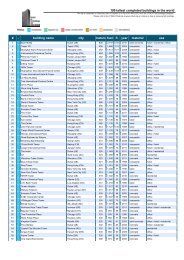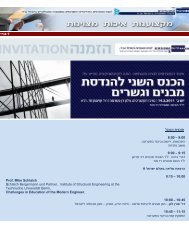צמנט רגיל צמנט : מסמך זה הוא הצעה בלבד מכון התקנים הישראלי
צמנט רגיל צמנט : מסמך זה הוא הצעה בלבד מכון התקנים הישראלי
צמנט רגיל צמנט : מסמך זה הוא הצעה בלבד מכון התקנים הישראלי
Create successful ePaper yourself
Turn your PDF publications into a flip-book with our unique Google optimized e-Paper software.
ועדה 10601EN 197-1:2011 (E)ForewordThis document (EN 197-1:2011) has been prepared by Technical Committee CEN/TC 51 “Cement and building limes”,the secretariat of which is held by NBN.This European Standard shall be given the status of a national standard, either by publication of an identical text or byendorsement, at the latest by March 2012, and conflicting national standards shall be withdrawn at the latest by June2013.Attention is drawn to the possibility that some of the elements of this document may be the subject of patent rights. CEN[and/or CENELEC] shall not be held responsible for identifying any or all such patent rights.This document supersedes EN 197-1:2000, EN 197-4:2004.This document has been prepared under a mandate given to CEN by the European Commission and the EuropeanFree Trade Association, and supports essential requirements of EU Directive(s).For relationship with EU Directive(s), see informative Annex ZA, which is an integral part of EN 197-1.Annexes A and ZA are informative.In addition to consolidating EN 197-1:2000/A1:2004, EN 197-1:2000/prA2, EN 197-1:2000/A3:2007, EN 197-4:2004 andEN 197-4:2004/prA1 into a single standard, the principal changes from EN 197-1:2000 are the introduction of additionalrequirements for common cements with a low heat of hydration and common cements with sulfate resisting properties.The preparation of a standard for cement was initiated by the European Economic Community (EEC) in 1969 and, at therequest of a member state later in 1973, the work was given to the European Committee for Standardization (CEN). TheTechnical Committee CEN/TC 51 was entrusted with the task of preparing a cement standard for the countries ofWestern Europe, comprising the EEC and EFTA members.In the early eighties, CEN/TC 51 decided to include in the standard for cement only those cements which are intendedfor use in any plain and reinforced concrete and which are familiar in most countries in Western Europe because theyhave been produced and used in these countries for many years. The EU Construction Products Directive (89/106/EEC)requires the incorporation of all traditional and well-tried cements in order to remove technical barriers to trade in theconstruction field. There are currently no criteria for the descriptions "traditional" and "well tried" and it was considerednecessary to separate the “common cements” from special cements, i.e. those with additional or special properties.The requirements in this standard are based on the results of tests on cement in accordance with EN 196-1, EN 196-2,EN 196-3, EN 196-5, EN 196-6, EN 196-7, EN 196-8, and EN 196-9. The scheme for the evaluation of conformity ofcommon cements including common cements with low heat of hydration and common cements generally accepted asbeing sulfate resisting are specified in EN 197-2.In order to find out which common cements are generally accepted as being sulfate resisting and should be included inEN 197-1, there was an investigation within CEN/TC 51 comprising all national specifications and recommendations inthe European Union. The review of these investigations led to the following results:⎯ a wide variety of cements has been classified in the EU Member States as sulfate resisting. This is due to thedifferent geographical and climatic conditions under which sulfate attacks on mortar and concrete occur at the placeof use and the traditionally different rules governing the production and use of sulfate resistant mortars andconcretes;⎯ sulfate resistance is an additional property and therefore sulfate resisting cements have first to conform to therequirements of the standards which define the product, e.g. EN 197-1 for common cements;4
















